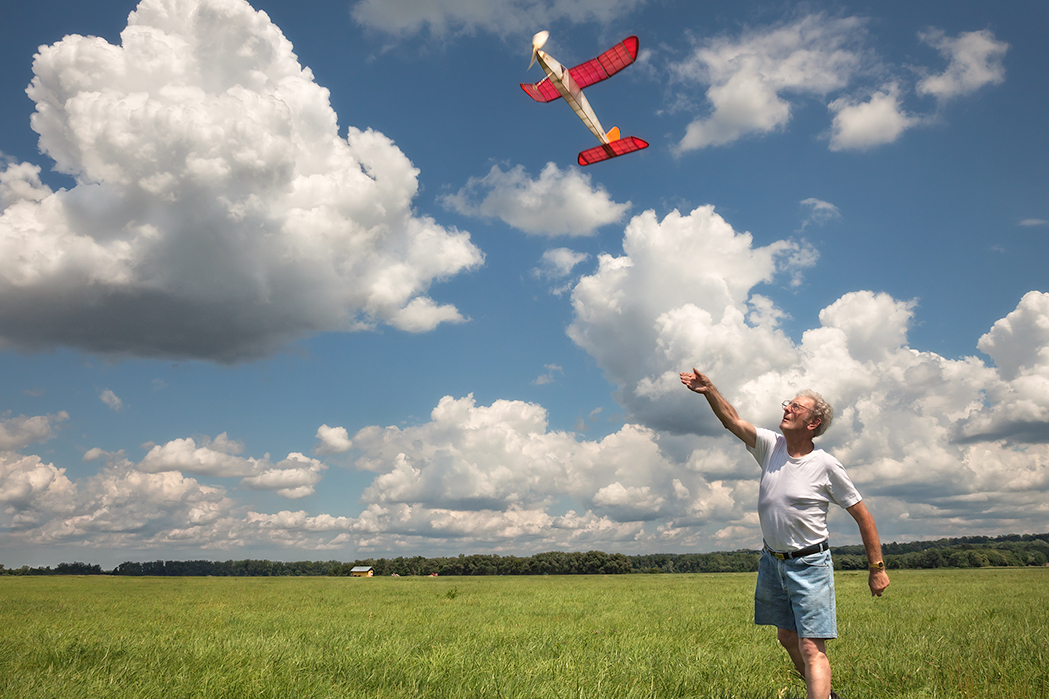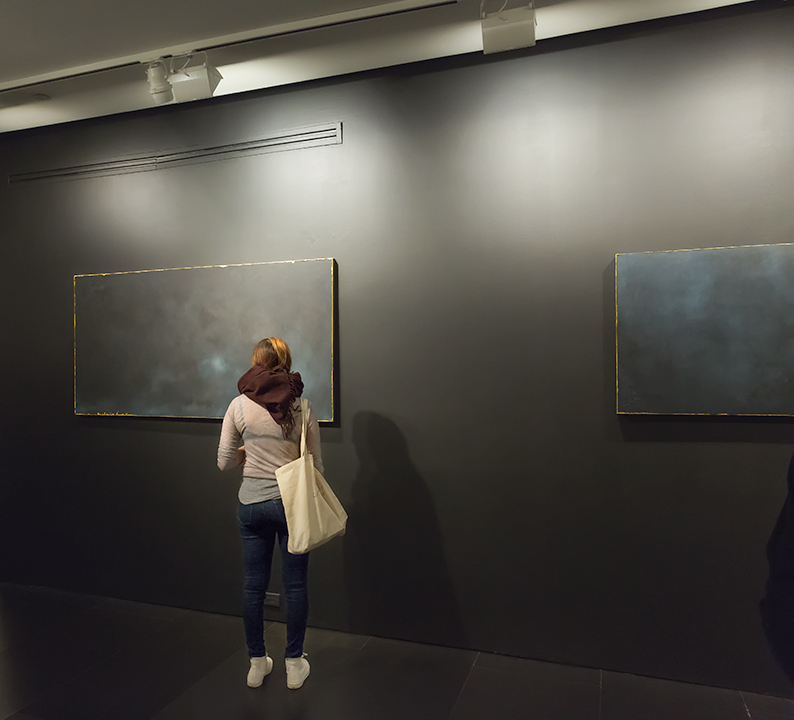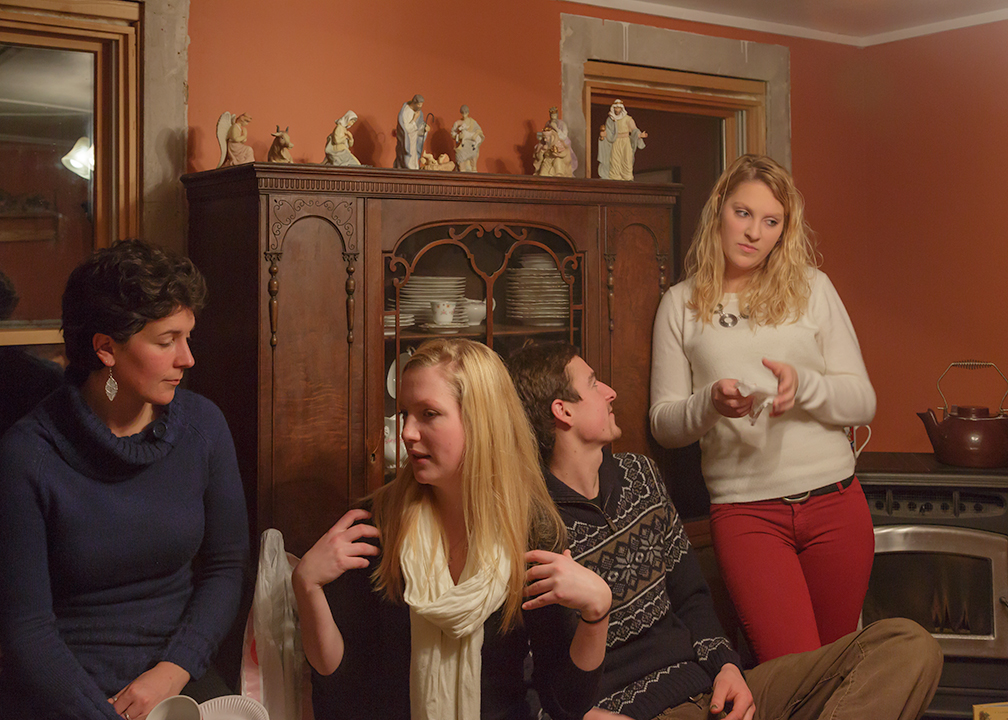Roger Bruce: My Unanticipated Fascination in the Ordinary
 © Roger Bruce
© Roger Bruce
My Unanticipated Fascination in the Ordinary
It is not surprising that the first image in the Roger Bruce exhibition, “My Unanticipated Fascination in the Ordinary,” is of a person pondering an image, for Bruce invites us to spend time looking at his own images—works that are anything but ordinary, they are engaging and quiet.
 At first glance, the photographs appear to be momentary snapshots—images that anyone could, and maybe, have made. But as a sequence of images, they collectively go beyond the first glance to a rich, and at times a dense play of the moment. Bruce, in his exhibition video interviews, refers to his photographic works as “notations,” paying homage to the ideas of Nathan Lyons (founder of the Visual Studies Workshop in Rochester, New York). Lyons refers to the camera as a “note-taking” device and the resulting images as “notations”—traces that are realized as a result of an intuitive, or unconscious recognition. As Bruce has suggested, it is a notation that reveals more over time, revealing the unseen through a sense of there is more to be seen. His images are silent yet, require more than a passing glance.
At first glance, the photographs appear to be momentary snapshots—images that anyone could, and maybe, have made. But as a sequence of images, they collectively go beyond the first glance to a rich, and at times a dense play of the moment. Bruce, in his exhibition video interviews, refers to his photographic works as “notations,” paying homage to the ideas of Nathan Lyons (founder of the Visual Studies Workshop in Rochester, New York). Lyons refers to the camera as a “note-taking” device and the resulting images as “notations”—traces that are realized as a result of an intuitive, or unconscious recognition. As Bruce has suggested, it is a notation that reveals more over time, revealing the unseen through a sense of there is more to be seen. His images are silent yet, require more than a passing glance.
Roger Bruce’s images invite the reader to take their time, to delve deeper into each photograph, and see what they have to offer. But this interaction requires patience and a consideration of the image within the context of his other photographic works. “My Unanticipated Fascination in the Ordinary” should not be experienced as a set of individual images (yes, each does work on its own), but as part of a larger whole speaking to Roger Bruce’s commitment and persistence.
Many of his images appear to be “staged”—a strategy used by many conceptual photographers who attempt to create a  scene resembling a moment captured in time (Photography has always addressed issues of time. Much contemporary work simulates the moment—a construction to either portray the moment of the real or constructs the surreal). However, Bruce’s photographs are not constructions, rather they are intuitive behaviors to a vision unseen. Bruce responds to the moment, which only reveals itself to him upon later reflection, not as documents, but as moments of insight. The act of photographing and its resulting image reveal to Bruce, and the viewer, more than what he initially noted. Thus, Bruce’s images demonstrate the “act of seeing” not merely as a conscious action, but as a sensory experience.
scene resembling a moment captured in time (Photography has always addressed issues of time. Much contemporary work simulates the moment—a construction to either portray the moment of the real or constructs the surreal). However, Bruce’s photographs are not constructions, rather they are intuitive behaviors to a vision unseen. Bruce responds to the moment, which only reveals itself to him upon later reflection, not as documents, but as moments of insight. The act of photographing and its resulting image reveal to Bruce, and the viewer, more than what he initially noted. Thus, Bruce’s images demonstrate the “act of seeing” not merely as a conscious action, but as a sensory experience.
This approach to photography—visual and intuitive—requires stillness by both the photographer and the viewer. It necessitates entering a space without assumptions or pre-visualized moments, but with a sense of presence—of being there.
 This, I suggest, is the heart of Bruce’s work and his approach to image-making. He works intuitively and only later layers various criteria and requirements on the image as he produces the print. His work is about moments, fluid everyday moments, passing us by without our notice. The camera, as a “notational device” freezes that moment, recording it for reflection and meditation. These are not decisive moments, but moments of decision.
This, I suggest, is the heart of Bruce’s work and his approach to image-making. He works intuitively and only later layers various criteria and requirements on the image as he produces the print. His work is about moments, fluid everyday moments, passing us by without our notice. The camera, as a “notational device” freezes that moment, recording it for reflection and meditation. These are not decisive moments, but moments of decision.
How many times have you stopped to look, maybe even take a photograph? You were not sure why, but you just had to. This is what Roger Bruce’s work “My Unanticipated Fascination in the Ordinary,” is about.
© Roberto Muffoletto, 2015